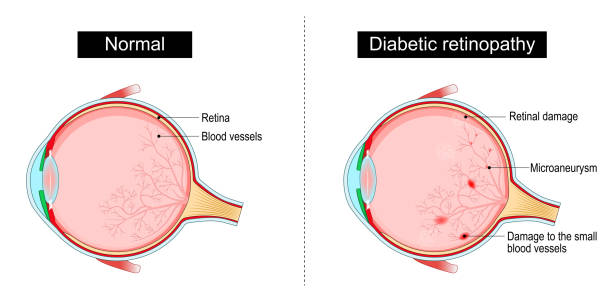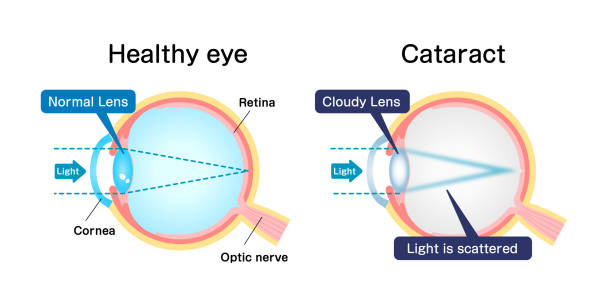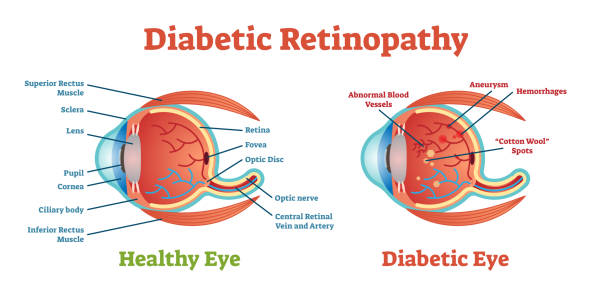Diabetes is a condition that affects millions of people worldwide. When you have diabetes, your body either doesn’t produce enough insulin or doesn’t use it properly. This can lead to high blood sugar levels, which may cause serious health problems, including those related to your eyes. In this post, we’ll explore how diabetes can impact your eye health and what you can do to protect your vision.
How Diabetes Affects the Eyes
Diabetes can cause a range of eye problems, including diabetic retinopathy, cataracts, and glaucoma. Understanding these conditions can help you take steps to protect your eyes.
1. Diabetic Retinopathy

Diabetic retinopathy is the most common eye disease caused by diabetes. It happens when high blood sugar levels damage the blood vessels in the retina, the light-sensitive tissue at the back of the eye. Over time, these damaged blood vessels can leak fluid, causing the retina to swell and leading to blurry vision. In some cases, new blood vessels may grow in the eye, which can cause further damage and even lead to vision loss.
There are two main stages of diabetic retinopathy:
- Nonproliferative Retinopathy: In this early stage, blood vessels in the retina weaken, but there is little to no impact on vision.
- Proliferative Retinopathy: This more advanced stage occurs when new blood vessels grow in the retina. These fragile vessels can bleed, leading to serious vision problems or blindness.
2. Cataracts

People with diabetes face a significantly higher risk of developing cataracts, a condition that causes the eye’s natural lens to become cloudy. This cloudiness leads to blurry vision, increased sensitivity to glare, and difficulty seeing in low-light conditions.
High blood sugar levels contribute to the faster progression of cataracts in diabetics, making early detection and treatment essential. Without proper care, cataracts can worsen over time, potentially leading to severe vision impairment or permanent vision loss. Regular eye exams, blood sugar management, and a healthy lifestyle can help slow cataract development and protect long-term eye health.
3. Glaucoma

Glaucoma is a serious eye condition that occurs when pressure inside the eye, known as intraocular pressure (IOP), increases to dangerous levels, potentially damaging the optic nerve. People with diabetes are at a significantly higher risk of developing glaucoma, particularly a rare but severe form called neovascular glaucoma.
This type of glaucoma is triggered by abnormal blood vessel growth in the eye due to high blood sugar levels, which can further restrict fluid drainage and increase eye pressure.
One of the biggest dangers of glaucoma is that it often develops without noticeable early symptoms. By the time vision changes occur, the damage may already be permanent. That’s why regular comprehensive eye exams are crucial for early detection and treatment. Proper diabetes management, including controlling blood sugar levels, blood pressure, and cholesterol, can help reduce the risk of glaucoma and protect long-term eye health.
Risk Factors for Diabetic Eye Problems
While anyone with diabetes can develop eye problems, certain factors can increase your risk:
- Poor Blood Sugar Control: Consistently high blood sugar levels can increase your chances of developing diabetic eye diseases.
- High Blood Pressure: Having high blood pressure along with diabetes can raise your risk of eye problems.
- High Cholesterol: High cholesterol levels can contribute to damage to the blood vessels in the eyes.
- Duration of Diabetes: The longer you have diabetes, the more likely you are to experience eye problems.
- Pregnancy: Women with diabetes who are pregnant may experience changes in their vision, known as diabetic retinopathy, due to hormonal changes.
How to Protect Your Vision When You Have Diabetes
Fortunately, there are steps you can take to protect your eyes and reduce the risk of diabetes-related vision problems. Here are some simple tips:
1. Keep Your Blood Sugar Under Control
The most important thing you can do to protect your eyes is to manage your blood sugar levels. Consistently high blood sugar levels can cause damage to the blood vessels in your eyes. Work closely with your healthcare team to monitor and control your blood sugar. This can be done through medication, diet, and exercise.
2. Get Regular Eye Exams
Regular eye exams are essential for catching early signs of diabetic eye disease before they become serious. You should have a dilated eye exam at least once a year, even if you’re not experiencing any vision problems. During this exam, your doctor will check for signs of diabetic retinopathy, cataracts, and glaucoma.
3. Maintain Healthy Blood Pressure and Cholesterol Levels
Managing your blood pressure and cholesterol is just as important as controlling your blood sugar. High blood pressure and high cholesterol can worsen diabetic eye diseases, leading to more severe vision problems. Eating a healthy diet, exercising, and taking prescribed medications can help keep these levels in check.
4. Eat a Healthy Diet
A healthy diet is important for managing diabetes and protecting your eyes. Focus on eating a variety of fruits, vegetables, whole grains, and lean proteins. Foods rich in antioxidants, such as leafy greens, carrots, and berries, can support eye health. Omega-3 fatty acids, found in fish like salmon and in flaxseed, can also help reduce the risk of diabetic retinopathy.
5. Exercise Regularly
Exercise is another key component of managing diabetes and maintaining overall health. Physical activity can help control blood sugar, lower blood pressure, and improve cholesterol levels. Aim for at least 30 minutes of moderate exercise, such as walking or swimming, most days of the week.
6. Quit Smoking
Smoking can worsen diabetic eye conditions by increasing the risk of damage to the blood vessels in your eyes. If you smoke, quitting can significantly reduce your chances of developing diabetic retinopathy and other eye problems. Talk to your healthcare provider for resources and support to help you quit.
7. Protect Your Eyes from UV Rays
UV rays from the sun can damage your eyes over time, leading to cataracts and other vision problems. Wearing sunglasses that block 100% of UV rays can help protect your eyes. This is especially important for people with diabetes, as they are more prone to cataracts.
Conclusion
Diabetes can significantly affect your eye health, but with proper care and regular eye exams, you can protect your vision. By keeping your blood sugar under control, managing your blood pressure and cholesterol, eating a healthy diet, exercising regularly, and quitting smoking, you can reduce the risk of serious eye conditions. Don’t forget to get your eyes checked regularly to catch any problems early.
If you are living with diabetes, taking proactive steps to protect your vision will help ensure that you can enjoy healthy eyes for years to come. By focusing on these prevention and management techniques, you can take control of your eye health and reduce the risk of serious complications related to diabetes. Stay proactive, and your eyes will thank you!

